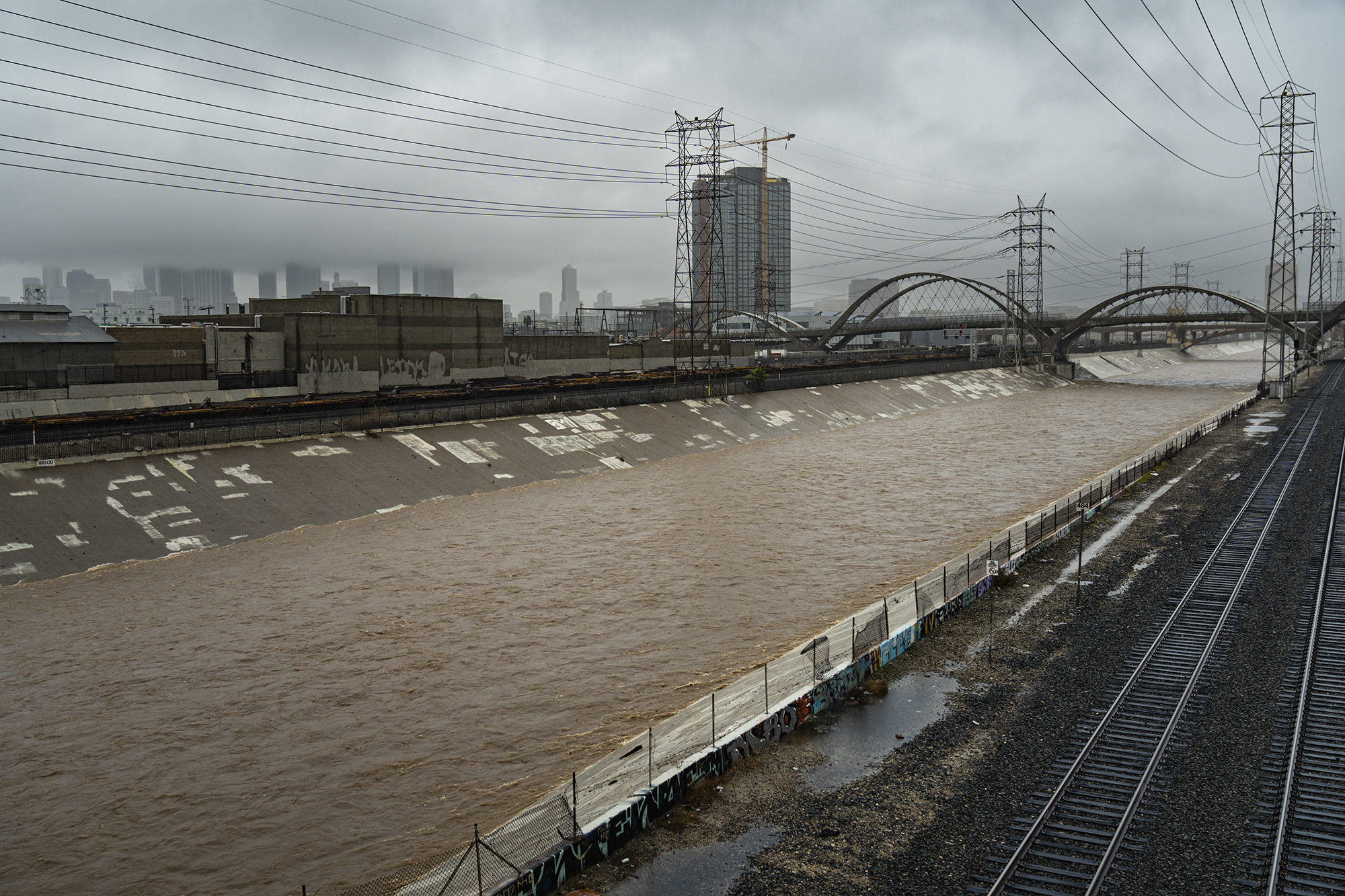

The Los Angeles River as seen from the 7th street bridge on the east side of Downtown Los Angeles. After 24+ hours of heavy rain the river was not close to overflowing, but was running swift and well beyond the usual trickle that typically runs through this area. February 5, 2024. Photo by Jules Hotz for CalMatters
California fails to capture massive amounts of stormwater rushing off city streets and surfaces that could help supply millions of people a year, according to a new analysis released today.
The nationwide report, by researchers with the Pacific Institute, ranks California ninth nationwide among states with the most estimated urban runoff. Rainwater flows off streets and yards into storm drains that eventually empty into waterways and the ocean — carrying pollutants picked up along the way.
The analysis reports California sheds almost 2.3 million acre-feet of precipitation from pavement, roofs, sidewalks and other surfaces in cities and towns every year. If it were captured and treated, that would be enough to supply more than a quarter of California’s urban water use, or almost 7 million Southern California households each year.
Los Angeles came in first in the West and 19th nationwide among 2,645 urban areas for amounts of runoff. An average of about 490,000 acre-feet a year of rainfall flows off pavement in the Los Angeles-Long Beach-Anaheim area — roughly the amount that the city of Los Angeles and some surrounding areas use in a year.
“What we’ve recognized, and are recognizing, is that stormwater is a resource that can be harnessed,” said Heather Cooley, co-author of the study and director of research at the Pacific Institute.
In recent years, former President Donald Trump and other Republican politicians and lawmakers have criticized California for “wasting” water that flows out to sea. At the Conservative Political Action Conference last week, Trump said a California congressman told him, “‘No, we don’t have a drought. We have so much water you don’t know what to do.’ But they send it out to the Pacific. We’re not going to let them get away with that any longer.”
But there are many reasons why stormwater flows into the ocean: Capturing it can be costly, requiring elaborate construction projects to trap and clean up or hold massive volumes of water.
And cities like Los Angeles are intentionally designed to protect people from floods by funneling large volumes of stormwater into channels and then out to sea.
“The whole area is designed with storm drains to capture all the flows so that people don’t get flooded, people’s property don’t get flooded,” said Adam Ariki, interim deputy director at Los Angeles County Department of Public Works. “We’re really trying to capture as much of it as possible. And with time, that number is going to go higher and higher and higher.”
In many cases, water containing oil, trash and other pollutants must be treated before it can be allowed to percolate into aquifers pumped for drinking water. In others, lack of open space limits where runoff could be allowed to seep naturally into the ground.
Also, in some controversial cases, particularly the Bay-Delta in Northern California, experts say stormwater must flow into rivers and the ocean to support fish and other wildlife. Growers and others in the Central Valley criticize that flows and call for more reservoirs, saying the water is wasted.
Sometimes there’s just too much rain at once to capture all of it. “Some flows may need to be sacrificed […]
Full article: mavensnotebook.com
An expanded plastic foam coffee cup is at a donut shop in Monterey Park, California.…
Nutrias were first discovered in the marshes of San Joaquin County in 2017. (Photo courtesy…
The Armstrong Ranch property, which occupies both sides of Highway 1, sits atop aquifers that…
Watersheds on the U.S. Eastern Seaboard will be among the areas most affected by underground…
An invasive algae has wrecked huge sections of reef in Papahānaumokuākea Marine National Monument. Scientists…
Sardine Meadow is a key link in conservation efforts for the Sierra Nevada, north of…